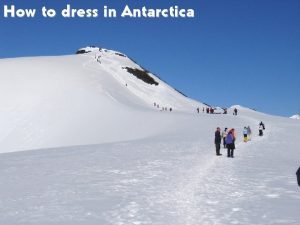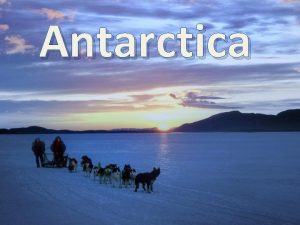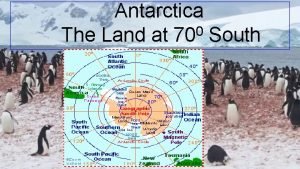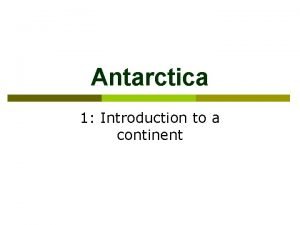Travel in Antarctica Copyright This resource is provided










- Slides: 10

Travel in Antarctica Copyright: This resource is provided free by Cool. Antarctica. com, you’re welcome. It cannot be distributed by any other means, believe it or not people sometimes lift free resources and distribute them pretending they have been allowed to or even sell them as their own – I know! It’s shocking! If anyone asks you for payment for this or if you get it but not from Cool. Antarctica. com, please email danthwhaler@gmail. com and the ghost of whaler Dan will exact retribution on the scurvy dogs. This copyright notice must appear wherever this material is used. Any queries please email

Sled dogs – first brought to Antarctica around 1900 following the example of their use in the Arctic by the Inuit. This was at a time when internal combustion engines were quite new and very unreliable.

Dog sleds remained the most reliable form of transport in Antarctica until the 1970’s when mechanical transport had improved sufficiently. They were also sometimes used as emergency food in extreme circumstances. They were removed from Antarctica in 1994 under the Antarctic Treaty as a non-native species. Those who travelled with dogs would often speak of the tight dependency of man and dog, practically and emotionally working as a team.

Manhauling – Pulling a sledge via a harness and a rope. This method was used in the early days of Antarctic exploration, but also used later on for the sake of convenience if travel wasn’t so common as it didn’t require the cost or continuous maintenance of dog teams or mechanical vehicles.

On good surfaces it is surprisingly easy to pull a very heavy sledge, typically 3 to 5 men would be harnessed to a sledge. It is very heavy work to do all day, especially if the surface isn’t so hard and smooth.

Snowmobiles - motor vehicles first went to Antarctica in 1907, they weren’t dependable enough in the harsh conditions compared to dog sleds until the 1960’s and 1970’s. They have the advantage that they don’t require much skill do drive one whereas dog sleds can be useless without a driver with at least some experience.

Their use requires backup support by air or the ability to radio for rescue by as they can take people a long way from the base, too far to walk back in an emergency

Food Requirements in Antarctica You need more food in a cold environment as you use it to burn up and keep you warm. An average adult uses about 2, 100 calories or 8, 700 KJ per day, here are comparative values for Antarctica. Energy requirements in Antarctica Manhauling sledges – 6, 500 calories (27, 300 KJ) Travelling by dog sledge – 5, 000 calories (21, 000 KJ) Travelling by skidoo – 3, 350 calories (14, 070 KJ) Working in buildings – 2, 750 calories (11, 550 KJ) Look at the energy used manhauling! That’s because it’s a sustained high output over many hours. The high figure for travelling by dog sledge is because much of the time can be spent walking or running alongside to reduce the load for the dogs. In difficult places, the dog driver also needs to get off and push. A dog consumes about the same amount of food energy as a man per day even though they are about half the weight.

You are about to go on a 100 mile journey into the "Field" - that part of Antarctica (the vast majority of it) that isn't on a scientific station to undertake a scientific survey. You equipment is carried on a long sledge and may be pulled by skidoo, dogs or human power. The spreadsheet gives your requirements in terms of food and fuel. You have to make your own balanced diet with enough energy too. This kind of trip is still carried out in Antarctica today, though only skidoos are now used, the last dogs were removed in 1994. Manhauling was a common method of transport during the Heroic Age of Antarctic Exploration from 1898 -1922 and may be used for short journeys especially where the sea ice may be unstable or thin.

Spreadsheet Instructions • Choose your method of travel, skidoo, dog sled or manhauling. This sets the length of time for your trip and the daily and total food needed. • Assemble the food you need from the list, these are the kinds of food used in travel boxes in Antarctica. This has been started for you. • Click on the first empty “Food Group” box (row 29) choose from the drop-down list. • Click the “Food Item” box in the next column, choose the food, go to “Quantity” and select how many. • You need to select enough food to turn the red (negative) figures in the “Difference to required daily calories” box to positive (green) so you have enough energy. • Make sure you have a balanced diet of fats, protein and carbohydrate, the pie chart will change as you add or remove foods, make it match the example as closely as you can, a little different is ok. • Wrap up warm and eat well! • I suggest you start with one day’s food, you can add enough food for the whole trip if you want to carry on, boxes I 27 and I 28 will tell you if you have enough food in total but not too much weight on your sled.


















